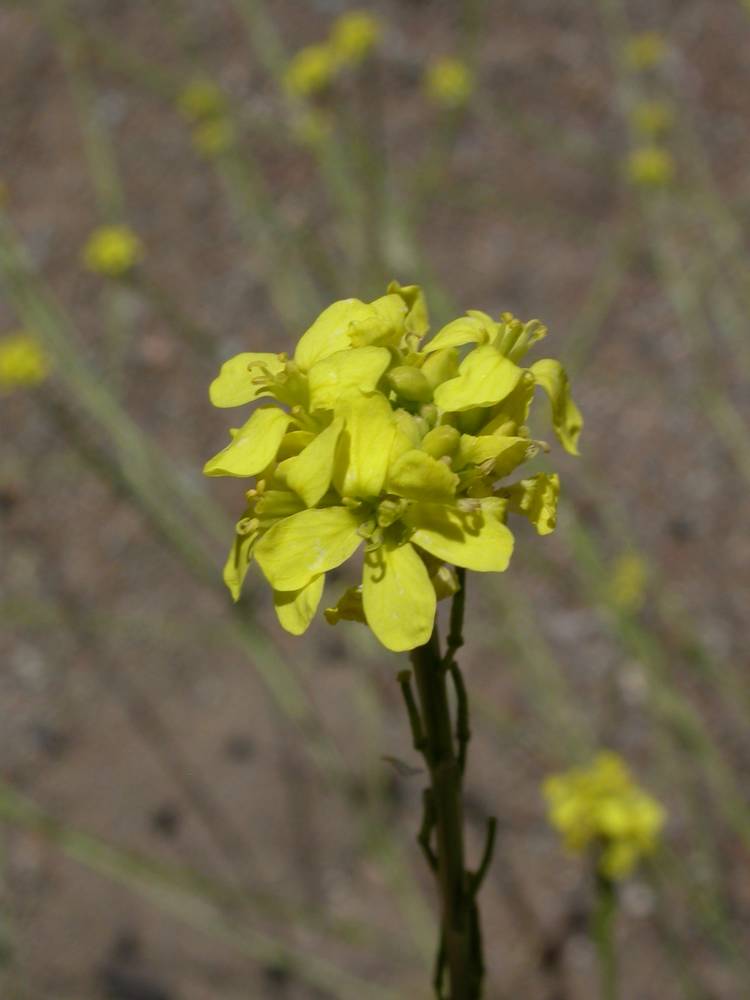
Herbs annual or biennial.
Trichomes simple.
Stems (2)4–15(20) dm, densely retrorse-hairy below.
Basal leaves rosulate, lyrate to pinnatifid, (3)4–22(35) × 1.5–6(8) cm, surfaces densely pubescent, terminal lobes broadly ovate, lateral lobes 1–6(9) on each side, ovate or lanceolate, smaller than terminal lobe, margins crenate-dentate; petioles 1–4(10) cm.
Cauline leaves similar to basal, bases not auriculate; subsessile or petiolate, uppermost leaves sessile.
Inflorescences bracts 0; fruiting pedicels erect, stout, 2–4(5) mm, almost as thick as fruit.
Flowers sepals widely spreading or reflexed, caducous, oblong, 3–5 mm, lateral pair not saccate; petals obovate, 5–10 × 2.5–4.5 mm, yellow, claws present, petal tips obtuse; nectar glands 4, not confluent, median and lateral; stamens 6, tetradynamous, anthers oblong, obtuse; ovules 10–22 per ovary, septa complete, styles present, stigmas capitate, entire.
Fruits dehiscent siliques, strongly appressed to rachis, linear, terete or slightly 4-angled, 7–15(17) × 1–1.7 mm, tips acute or obtuse; valvular segments 8–20-seeded, not torulose, 6–10 mm, terminal segments indehiscent, slightly swollen, 3–6 mm, seedless; valves 3-veined; replums rounded.
Seeds 1–2, uniseriate, ovoid or globose, 0.9–1.5 mm in diameter, mucilaginous when wetted; wingless; cotyledons conduplicate.
2n=14.
Roadsides, disturbed areas, canyons, creek bottoms, dry fields, open desert. Flowering Mar–Nov. 0–2000 m. CR, Est, WV. CA, NV; Africa, Asia, Europe. Exotic.
as described under Hirschfeldia incana
Stems (2-)4-15(-20) dm, densely pubescent proximally, trichomes retrorse. Basal leaves: petiole 1-4(-10) cm; blade (3-)4-22(-35) cm × 15-60 (-80) mm, lobes 1-6(-9) each side, ovate or lanceolate, (smaller than terminal), terminal lobe broadly ovate, surfaces densely pubescent. Cauline leaves (distal) ± sessile; blade oblong to lanceolate, similar to basal, (smaller distally). Fruiting pedicels (appressed to rachis, almost as thick as fruit), 2-4(-5) mm. Flowers: sepals 3-5 × 1.2-2 mm; petals 5-10 × 2.5-4.5 mm; filaments 3-5 mm; anthers 1-1.5 mm. Fruits 0.7-1.5(-1.7) cm × 1-1.7 mm; valves 6-10 mm; terminal segment 3-6 mm. Seeds 0.9-1.5 mm diam. 2n = 14.Flowering Apr-Nov. Roadsides, waste places, disturbed areas, canyons, creek bottoms, dry fields, open desert; 100-1600 m; introduced; Calif., Nev., Oreg.; Eurasia; nw Africa; introduced also in South America, s Africa, Atlantic Islands, Pacific Islands (Hawaii), Australia.Hirschfeldia incana was first collected in North America in 1895 in the San Bernardino region, and by 1936 it was described as 'already a serious agricultural pest, spreading freely over dry, unbroken ground and flourishing chiefly during the arid summer season' (W. L. Jepson 1909-1943, vol. 2).Hirschfeldia incana can be confused with Brassica nigra because both have fruits appressed to the rachis. The former is distinguished from the latter by its distinctly shorter fruit, seeded and often swollen beak, and smaller petals.